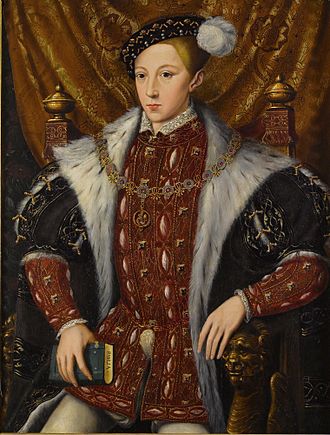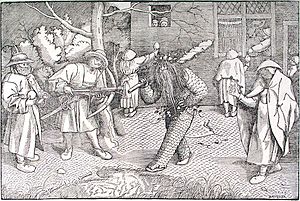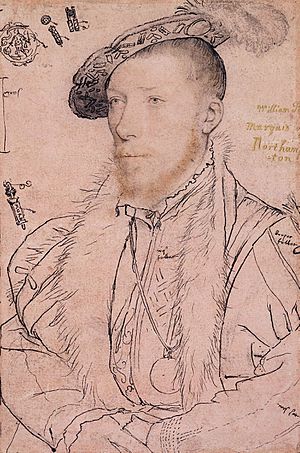Coronation of Edward VI facts for kids

Portrait of Edward VI
|
|
| Date | 20 February 1547 |
|---|---|
| Location | Westminster Abbey, London, England |
| Participants |
|
The coronation of Edward VI as King of England and Ireland took place at Westminster Abbey, London, on 20 February 1547. Edward ascended the throne following the death of King Henry VIII.
Contents
Background
Henry VIII died on 28 January 1547. Edward was nine years old. He was brought from Hertford Castle to Enfield, where he joined his half-sister Elizabeth. He was proclaimed king on 30 January. Edward later wrote that the cause of his father's death was dropsy. Henry was buried at Windsor next to Jane Seymour, Edward's mother, on 16 February.
The Privy Council deliberated on the late King's will concerning the succession.
The day chosen for the coronation was Shrove Sunday. An order of service was drawn up under the authority of the Lord Protector, Edward Seymour, 1st Duke of Somerset, and the executors of Henry VIII. After Edward was crowned with St Edward's Crown, the Protector would be first to hold up his hand to pay homage.
The king's older half-sisters Mary and Elizabeth and attendant ladies and gentlewomen seem not to have been invited or present at the coronation events, possibly due to considerations of relative precedence and expense.
Contemporary descriptions of the ceremonies of his royal entry on 19 February and the coronation on 20 February are held by the College of Arms and the Society of Antiquaries.
A new crown for Edward
Three crowns would be used, including a new "imperial" crown made by the goldsmith Everart or Everard Everdyes from gold, precious stones, and pearls. The word "imperial" signifies the style of a crown, with raised arches. Everdyes used scrap gold from the Secret Jewel House including a set of nine letters "I" or "J", perhaps originally made for Edward's mother Jane Seymour. The new crown was set with pearls from Henry VIII's collars and caps, and may have included the large balas ruby of the Black Prince, a stone sourced in Myanmar. Everdyes' crown was detailed in Edward's inventory:
Everdyes also made a coronet for the Duke of Somerset, embellished with Henry VIII's diamonds. After the coronation, he returned unused pearls taken from the jewels of Henry VIII to the Jewel House. His workshop was located at Westminster Palace. In 1604 the large ruby in Everdyes' crown was described again as "a verye greate ballace perced".
Procession and pageants


Edward and his entourage travelled in a royal entry procession from the Tower of London to Westminster through the city of London on 19 February. Two gentleman ushers, John Norris and William Raynesford, dressed in vintage costume as the Dukes of Normandy (or Gascony) and Guyenne, represented Edward's claim to these territories. Edward was dressed in a "rich gown of cloth of silver all over embroidered with damask gold". During the procession, he sometimes walked a little ahead of the ceremonial canopy held above him, so "the people might better see his grace".
Citizens of London were taxed to pay for the shows and pageants. Edward was greeted at Cheapside by actors playing Valentine and Urson (Orson). These were twin brothers, warriors who had been lost as children. Urson was brought up by a bear and became a wild man or wodewose, while Valentine was found in a forest by Pepin the Hunchback and raised as a courtier. In the London pageant, they undertook to defend King Edward. Urson's verses included:
The pageants at Cheapside were based on a performance staged in 1432 for the return of Henry VI of England from France. The script involved material from Robert Fabyan's edition of the works of John Lydgate.
At Fleet Street, Edward was addressed by "Ancient Truth", who had been restored by Henry VIII and looked forward to Edward's reign as a "young King Solomon". At St Paul's, an acrobat, "a man from from the nation of Aragon", slid down a cable or tightrope from the steeple battlements "so swiftly as he had been a bird". Edward watched him perform more tricks on the rope, and "laughed right hartely". This was the only place where the procession paused for any length of time; the king at times bypassing pageants and ignoring speeches made to him.
Coronation

The ceremony in the Abbey involved the Coronation Chair, which survives today. The chair, described as the "great white chair" was draped with rich white fabrics, supplied by William Green. On the back of the "white chair" were two carved lions on the corner posts and a fleur-de-lis on a turret topping the centre. The chair was placed on steps on a stage called a "mounting scaffold" watched and guarded by the ushers, John Norris, William Raynesford, Richard Greenway, and Richard Blount of Iver and Mapledurham.
Edward showed himself at the four corners of the scaffold and Thomas Cranmer, Archbishop of Canterbury said the words of "recognition", inviting the congregation to assent to the coronation by their "duties of allegiance". As Edward was required to move to various positions in the abbey during the service, the ushers carried him in a portable chair.
The Coronation Oath had been amended to reflect the Reformation; mention of the priviledges of the clergy were omitted and a veiled reference to the Parliament of England was introduced, that new laws would be made "by the consent of your people". In his sermon, Cranmer set out a Protestant agenda by likening Edward to the Biblical Josiah, who had destroyed the pagan idols in Jerusalem, and said the new king would see "the tyranny of the Bishops of Rome banished from your subjects and images removed". Edward was crowned by the Archbishop of Canterbury. Somerset assisted in the crowning, and with the Archbishop, brought the three crowns, a newly made crown, the Imperial State Crown and St Edward's Crown, to the altar and "set them one after another on his head".
A general pardon for prisoners was issued, excepting the Duke of Norfolk, Edward, Lord Courtenay, son of the Marquess of Exeter, Master Fortescue or Foskew, Cardinal Pole, and Doctor Pates. Some sources add Nicholas Throckmorton to the exceptions from the pardon.
Banquet
Edward came into Westminster Hall from the abbey in procession. He wore the new crown made by Everart Everdyes. The Marquess of Dorset was Constable of England, and the Earl of Arundel was Earl Marshal. They rode into Westminster Hall at the service of the first course. The Marquess of Northampton was carver and he assayed, or tested, the food. The Earl of Rutland held the king's towel in the place of Alan Apsley.
At the conclusion of the service of dinner, the King's Champion, Dymoke of Scrivelsby, rode into the hall in armour. He cast down his gauntlet as a challenge to any who questioned the king's right. Edward gave him his gold cup, and he was rewarded with the value of his arms and armour. At the end of the meal the spiced wine hippocras was served, followed by a course or "void" of spices and sugar confections.
Tournaments and masques
On Monday 21 February there was jousting, and a tournament on 22 February. The competitors included Thomas Seymour, Anthony Kingston, Peter Carew, Francis Knollys, and Edward Shelley. Shelley was killed in Scotland later in the year at the battle of Pinkie.
After the tournament, or on the next evening, there was an interlude or "farce" which included the theatrical presentation of Orpheus on a mount (refurbished by Niccolo da Modena), and a masque including players dressed as friars and cardinals. Edward may have performed in this entertainment in costume.
English soldiers at Boulogne held a tournament to celebrate the coronation. Instead of tilting, they held courses of running at the ring. One team of six were dressed "like Turks". Spectators were impressed by the performance of Henry Dudley.
In fiction
The coronation of Edward VI is the backdrop of Mark Twain's 1881 novel The Prince and the Pauper. In the novel Edward is lost and helped by Miles Hendon to reach the abbey before the lookalike Tom Canty is crowned. The novel has been adapted as a stage play and filmed many times, including, The Prince and the Pauper (1977 film) in which Hendon was played by Oliver Reed.
Twain may have read of the pageant of Valentine and Orson in his researches. Chronicle accounts of the reign of Mary I mention an imposter, William Featherstone, the son of a miller and a servant of Peter Meutas, who claimed to be Edward VI in 1555. He was shown to the people in Westminster Hall, and imprisoned. Featherstone was hanged on 13 March 1555.
See also
- Cultural depictions of Edward VI



